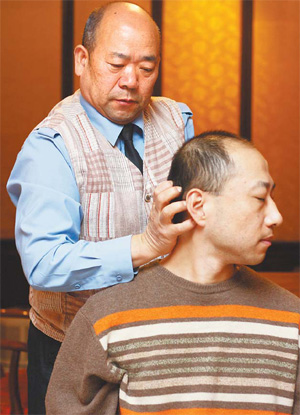
|
LIFE> Health
 |
|
Restoring harmony with 'push and grab'
By Ye Jun (China Daily)
Updated: 2009-08-05 16:23
 In 1999, a 36-year-old factory worker, surnamed Fan, in Hebei's Yongnian county, suffered a whiplash injury that displaced the spinal discs, in a terrible traffic accident. After lying in a coma for half an hour, he woke up almost paralyzed, besides suffering from incontinence. While others in the same situation may have had to suffer for the rest of their lives, Fan was lucky to find Hu Jinjiang, professor of medicine with the clinic affiliated to the Air Command in Beijing, two months after his injury. Dr Hu Jinjiang is known for his tuina, a therapeutic massage used in traditional Chinese medicine. Wang Jing Hu treated him with what he calls tuina, or "push and grab", a therapeutic massage used in traditional Chinese medicine. In a week, Fan could sit up; six weeks later, he could walk by himself; months later he was able to take care of his daily routines independently and was also rid of his incontinence. Fan is just one of hundreds of thousands Hu has treated successfully over the past few decades. Hu, 59, director of the Tuina Center, is particularly well-known for treating problems with the cervical vertebrae, slipped discs, abnormal curvature of the spine, and frozen shoulder, besides injury to bone joints and soft tissue. The kneading, rolling , pressing and pinching involved in a typical massage session make it appear as if Hu is applying great strength, but patients often feel no pain and usually report having better joint mobility. The basic theory of Hu's treatment is that the ligament holding the spine is loose on the inside and tense on the outside. This makes the spinal cord susceptible to shift out of place in the event of a sudden injury, such as a whiplash. Hu applies a unique set of hand techniques to correct imbalances in the ligament. He says he has successfully treated 1,603 cases of injury to the cervical vertebrae between 1975 and 2005. Detailing his treatment method, he isolates five distinct steps: widening the inter-vertebral disc space, correcting the backward protrusion of the neck, manipulating the nearby soft tissue, stimulating the acupuncture points, and ensuring the flow of qi, or energy, along the spine. Hu started his medical career as a young soldier in an army clinic. He was tasked with helping fellow soldiers with muscle and joint problems. Later, he underwent formal training at Beijing Medical University. He says his treatment borrows from Western medicine, the traditional Chinese theory of qi, and from martial arts. "I have drawn inspiration from tai chi, and my set of hand techniques are based on tai chi and my knowledge of anatomy," he explains. Hu says he needs to keep his own energy levels up in order to treat his patients. Even at 59, the fit doctor can do push-ups on a single hand. He attributes this to tough martial arts practice when he was young. To prevent problems with the cervical vertebrae, Hu says one should only move the head from left to right and up and down, and not in any other direction. "The human head is designed for movement only in these two directions," he says. He also advises against eating very hot foods, saying that such foods can loosen the ligaments located at the back of the gullet, and distort the spine's natural curvature. So far Hu has published 39 dissertations and six books on his school of tuina. He has traveled to more than 20 countries and taught his skills to nearly 2,000 doctors from home and abroad. |